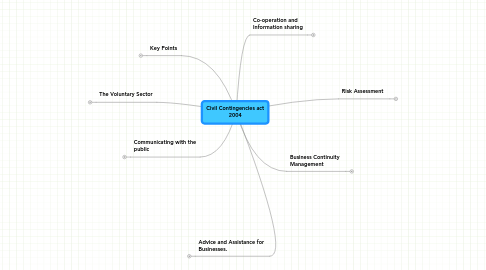
1. Key Points
1.1. Deadly Floods at the turn of the century provoked its development, NOT 9/11
1.2. The Bill spent 10 months in Parliament
1.3. The biggest challenge the Government face is IMPLEMENTING it.
1.4. Communities are involved in the implementing process.
2. Advice and Assistance for Businesses.
2.1. Local authorities are legally obliged to provide advice, especially smaller companies.
2.2. Effective Business Continuity Management is built on "7 P's":
2.2.1. Programme
2.2.2. People
2.2.3. Processes
2.2.4. Premesis
2.2.5. Providers
2.2.6. Profile
2.2.7. Performance
2.3. Big companies such as Marks and Spencer may have their own emergency slogan
2.3.1. People
2.3.2. Property
2.3.3. Profit
2.3.4. Brand
2.3.5. They change places during implementation.
2.4. This is a Multi-Agency Programme.
3. Communicating with the public
3.1. International and local media are key
3.1.1. The London bombings are a good example for this
3.1.1.1. Eyewitness accounts were gathered almost right away.
3.1.1.2. The amount of bombs was established (3 on underground trains, 1 on a bus)
3.1.1.3. Localized information was not given to news channels fast enough, causing traffic jams.
3.2. Category 1 Responders have the duty to 'warn and inform'.
3.3. The first point of contact is at regional or local level.
3.4. BBC set up 'Connecting in a Crisis'
3.4.1. It provides information to the public about an ongoing disaster
3.4.2. It delivers essential information quickly
3.4.3. It encourages emergency planning
3.4.4. It was sent to every blue light service and emergency planner in the UK.
3.5. Environment Agency introduce a new early warning system for flooding.
4. The Voluntary Sector
4.1. They are becoming more important
4.2. They are always here to help.
4.3. There is an endless list of voluntary agencies. (St John Ambulance, Red Cross etc)
4.4. Category 1 Responders are required to work with voluntary agencies in planning, implementing plans etc.
5. Co-operation and Information sharing
5.1. Co-operation is paramount for its success!
5.2. Emergency planning requires everyone to work together.
5.3. It introduces the concept of category 1 and category 2 responders.
5.3.1. Category 1 Responder- Blue light services. They are at the core of response to most emergencies.
5.3.2. Category 2 Responder - Utility services, Health and Safety Executive. Less likely to be involved in the heart of the planning but will be heavily involved in an emergency that affects their sector.
5.4. Introduction of the Local Resilience Forum
5.4.1. Category 1 and 2 Responders come together (based on police areas) which helps co-ordination and co-operation between the services.
